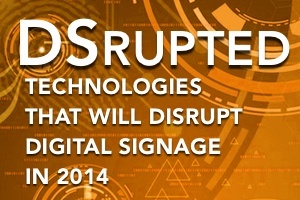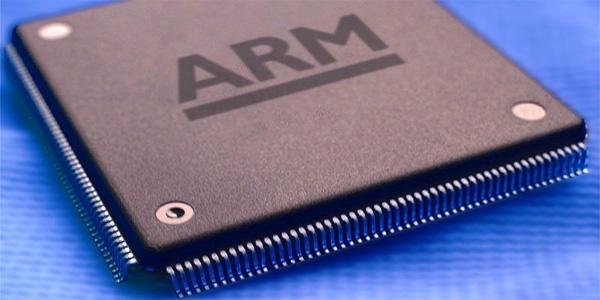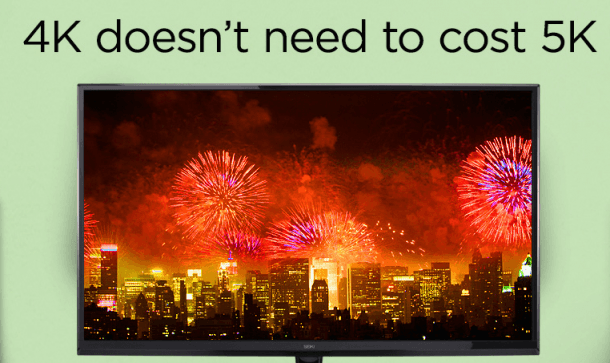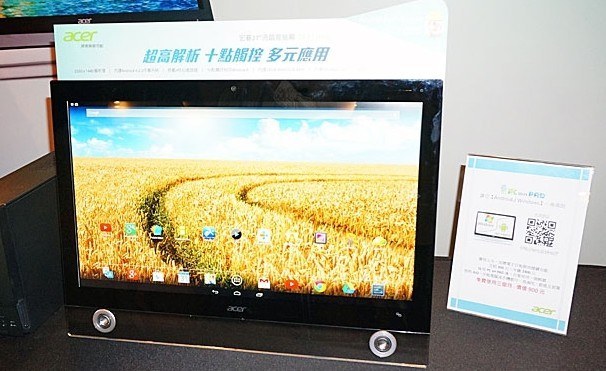
DSrupted: Technologies That Will Disrupt Digital Signage In 2014
December 23, 2013 by Dave Haynes
I define disruptive technology as software, gear and infrastructure that significantly changes how things have long been done and used.
Minor disruption is happening all the time in the digital signage space. But I think 2014 will see some major disruption, on a number of fronts.
Here’s a rundown of what I see happening (helped along and sanity-checked by some industry contacts):
HTML5

Here’s how HTML5 is disruptive to the sector and its eco-system. An interactive company with a large client, that already does its mobile and other online work, can also do its base digital signage using just the web tools provided by HTML5.
You produce and publish once, and responsive designs and the right browsers show the content based on the device. Instead of a silo’d content management system that solves one piece of the puzzle, and maybe integrates with the web publishing system, the web publishing system is the full solution.
Does a web solution match up with a digital signage CMS? Nope, not close. Will a lot of companies that just want to extend messaging to more screens care? Probably not, particularly if it means they don’t have to bring on another tech vendor and using web tools will control costs.
HTML5-based, fully web-driven systems won’t give end-users some critical things like advanced device management. It’s a presentation layer and there are challenges inherent in using something not really classic forward and store design of digital signage systems. For one thing, you’ve got to make the browser cache and locally store the media, and that has its limitations.
But if the web developers are sharp, there are solutions, as well as third-party device management solutions. Jim Nista of Insteo does a lot of work with HTML5 and confirms there are times when there is no compelling argument to be made for putting a commercial CMS in the middle of a small business signage solution.
I have recently seen an early stage, fully HTML5-driven commercial CMS – coming out of the start-up/tech hotbed of Waterloo, Ontario – that was slick as hell in terms of the user interface and functionality. Because they started from scratch, instead of adapting a legacy software build, they were able to take full advantage of the tools out there. The product wasn’t quite ready for the market, and the pricing model was suspect, but it was, and is, very interesting.
The other thing about HTML5 is that it will inevitably supplant Flash. Adobe’s Flash Player was a big part of digital signage for the last dozen years, but it will be steadily taking over from Flash because of the big shift in devices from full-throated x86 PCs to low-cost, teeny playback gadgets made with ARM processors.
Low cost and small size both tend to come with compromises, one of them being processing power. Flash needs a lot of CPU to do its thing well, and HTML5 does not. Big challenges exist right now in terms of what browsers and capabilities all those little boxes and HDMI sticks support, with some saying they are HTML5 ready, but really aren’t. “HTML compliancy” is a moving target.
However, standards will develop and evolve, and you’ll see – as is already evident – little devices doing dynamic updates and showing motion graphics just like Flash can do, but at a fraction of the hardware cost.

ARM processors
There are now dozens of different Android-driven digital signage solutions on the market, and most or all of them are running off processors, using ARM reference designs, that are common to smartphones, tablets and smart TVs.
More will come, for the simple reason that they drive costs down and down.
I have had private chats with industry friends who sell PCs in the digital signage space. They know their companies either have to adjust their product suite to include much lower-cost ARM devices, or they need to find new employers and sell different stuff.
Certainly, there is room in the ecosystem, and demand, for Intel and AMD-based x86 computers. But increasingly, that will be the niche part of the market, not the dominant part as it has been since people started connecting PCs to TVs and calling it digital signage. Then again, there are now people touting the $45 Raspberry Pi boards as video wall playback devices. I wouldn’t advocate that, but …
The Indian company that manufactures the basis of Google’s ChromeCast HDMI stick – Marvell – has a booth at Digital Signage Expo. Suffice to say the company is not likely there to help sell $35 NetFlix players. The company’s Armada 1500 media processor can drive digital signage solutions, and you should expect partnership announcements in the new year from the company.
I have even heard there is an ARM-based player coming next year that can do 4K video. Bryan Mongeau, VP Technology at BroadSign, follows the ARM and display market closely and keeps a close eye on a handful of Chinese manufacturers who are particular pushing the capabilities of these devices.
If your company is in software, and you’re determined to stick with Windows and Intel chipsets, you may have a tough few years ahead. Mongeau was one of the early ones to see the shift, and led the development and what sounds like a very successful launch of an Android-ARM product this past year. He doubts there will be much reason for any end-user – save some specialty projects – to use an x86 (PC) chipset by the end of 2015.
Another industry insider told me his company still uses Intel’s Atom processors on some jobs, but even those low-end chips are 3X-4X the cost of ARMs with similar processing power.
Stratacache CEO Chris Riegel says there will be developments in ARM and digital signage in 2014 that will be “earth shakers” for the industry because of the cost implications.
Projection Mapping
If you don’t know what this phrase even means, get schooled.
I just wrote a book about this relatively new approach to digital media, and some of the projects already done using projections are remarkable – applied to everything from massive buildings to scale model cars.
Briefly, projection mapping is the umbrella term for using high-powered data projectors to accurately illuminate a surface and change its appearance and characteristics using motion graphics.
You may have seen videos of huge projects like illuminating the Sydney Opera House’s iconic roofline, ancient castles or even Quebec City’s riverfront grain silos. Those take big budgets and a lot of skill and experience to pull off. The difference is that projection lighting power and set-up software are at a point now that projection mapping is not the sole domain of specialists. It’s getting “relatively” easy to design and pull off complex illumination projects.
Already, the market has started hitting from one-off projection events to full-time installations, like in Montreal’s arts quarter. You’ll see more of that, and the body of knowledge on how to install, protect and manage projectors is much richer than it was a few years ago.
So why is all this disruptive?
Any surface can, at night, or indoors when the lighting conditions are right, be a vast, intriguing and steadily morphing canvas for digital. Structures and facades are no longer constrained by intrusive windows and doors. With projection, nothing needs to be hung on a wall. No holes are needed for fasteners. The intrusive doors and windows can be built into the design. With projection, building engineers and preservation specialists don’t need to approve what’s going to be done, because it’s all virtual.
Objects like cars can be draped in light fabric and accurately projection mapped, so that colors and options can be projected on demand. I saw a Christie demo that has a 3D-printed scale version of an Audi made into an interactive gallery.
What will be possible with projection is fascinating. What’s been done to date is just a hint, and I think we’ll be seeing a lot more in the coming year or two. This will not replace more conventional displays in most cases, but add new digital canvases in places and in ways that weren’t previously possible.

Chinese Displays
Remember these names – Seewo, Seiki, TCL, Xiaomi and Hisense. They are Chinese TV manufacturers, and some or all of them are likely to do commercial large-format panels at prices South Korean and, certainly, Japanese manufacturers can’t touch. On the TV side, they are already marketing in the US 4K ultra high def TVs at less than $1,000.
Yes, they are TVs. Yes, they are Chinese, so build qualities may be suspect. But yes, they will put big price pressures on the dominant display guys in the space now.
Guangzhou Shirui Electronics Co., Ltd, aka Seewo, has a booth at DSE. So does Seeyoo Electronic & Technological Co., Ltd.
The Chinese – because of their manufacturing costs – were going to inevitably shake things up. What fascinates Mongeau, who’s been to China for a close look, is how the mindset is no longer centered around making cheaper copies of exiting product, but instead around innovation.

SaaS/Managed Services Growth
Read a few business IT forecasts and you can pretty clearly see indicators of why more and more companies will opt for software as a service for their digital signage platform.
The biggest reason is time and resources. Digital signage is a something that will only in the rarest cases be regarded as mission critical, so a SaaS CMS means more staffing is left available to deal with the truly important staff, like data integrity and network security (which is steadily at risk).
Offloading the servers and even the data connections to vendor management also frees time for IT departments to deal with the waterfall effect of the Bring Your Own Device movement. Once the standards are relaxed and companies allow a broad spectrum of smartphones, laptops and tablets, IT help desk demands tend to skyrocket. So the idea of SaaS, with browsers instead of newly installed software, and no new servers to water and feed, has a distinct appeal.
But SaaS also has a problem that will likely grow this year – price. Pitching SaaS deals can come down to a monthly number – and a race to the bottom on that number. It’s hard to do many deal at $40/month for SaaS, with competitors out there selling something that at least “seems” very similar for half or even a quarter of that.
Or in the case of Rise Vision or NEC’s CMS, is free.
In the broader context, you will see managed services offers grow across companies in this eco-system because end-user clients don’t want to take the work on themselves. In the past year, I’ve worked with companies with 10,000 and others with less than 100, but the story was the same. It didn’t matter if the software was easy to use and the tools and templates were supplied. They didn’t have the resources or hours to do the job themselves, and were buying right into the argument that outsourced services were going to be easier and cheaper than they’d be if handled in-house.
Riegel says he has seen the 70:30 ratio of in-house vs managed services flip completely, and now the majority of clients get work outsourced. In most cases, he can do the work – scheduling, monitoring, whatever – at less cost and better than it could be done internally.

Big-Ass Tablets
A LOT of tablets – both iOS and Android – are starting to find their way into retail environments as slim, nicely packaged yet powerful merchandising and messaging displays. They make for great electronic fact tags (see Apple stores) and networked meeting room signs.
But … tablets that tend to max out at 10 inches are small. The consumer marketplace really doesn’t want a 12 or 15 inch tablet, so they’re not being made. But there is a subset of larger all-in-one devices that can serve the signage market for what I’d call big-ass tablets, or super-tablets, as large as 22 inches, that would effectively and very nicely replace all kinds of retail and public posters. They get really good when they have touch overlays.
There’s also an obvious market for much larger all-in-ones. Samsung made the first big jump for a major displayco when it turned its consumer Smart TVs into commercial Smart Signage products. My guess is you will see more Smart TVs tweaked to be commercial panels, and we’re already seeing some Taiwanese companies, like Acer, release all-in-ones. Chinese displayco Hisense has a new series of TVs that run Android 4.2 that would in theory make for smart signs.
Mongeau’s ideal is what amounts to a crazily oversized 47-inch tablet that has a quality touch overlay, runs at least Android 4.2, and has a fast CPU. It’s a device that could run digital signage, really, as nothing more than an app.

Smart Machines
The internet of things is a buzz phrase that’s been around for a few years now. Unlike some hyped tech, this stuff is real and hugely diverse. Machine to machine connectivity, networking, sensors and transmitters, and low cost/teeny computing devices mean we are shifting rapidly into a world where ALL KINDS of things are online and providing data.
Look at what Nest is doing with residential heating and cooling, and now smoke and CO detectors. They learn homeowner usage patterns and adjust, and the devices talk to one another.
Now think about all the systems in public spaces and retail, and all the sensors and data generated, and how that can be applied.
Here’s a good example: At the airport in Charlotte, N.C., there are multiple TSA security/screening areas. One end is always busy because that’s where the airline counters are located, while others down the way are not busy because they’re away from the bustle in a newer part of the twerminal. I’ve been through there when TSA staff and airport security have been pulling people out of the back of lines and telling them to walk down 100-200 metres, to where there were no lines. They had more people intercepting passengers as they headed down that way, and directing them to the right TSA area.
With cameras analyzing line-up lengths and feeding that data a content management system, screens could be telling people line-up times and where they are shortest, and then where they are. Without using staff better deployed right in the screening areas.
Watch in the next year how Apple applies its iBeacons technology in its own stores to get relevant messages to customers, and improve their experiences through what will be pretty simple means. They will recognize customers based on apps on their phones, and message base don shopper profile and even where they are in the stores.
When data from all kinds of “smart” machines can make something faster, easier and generally better – and tie big screens to the little screens in people’s hands – that’s a winning formula. It elevates the experience.
All that data will also inform end-users about what’s going on. You have the potential to shift marketing and messaging from plans based on what has happened in the past, to what’s happening at that moment, in that place, in near-real time.
This is, of course, contingent on software, systems and smarts to pull all this together. But smarts machines and their data are just the logical evolution of triggered content and programming.
Wild Cards
Here are some wild cards for disruption:
Programmatic buying – Media placement based on algorithms instead of meetings and nice lunches – will definitely grow in this space, led by companies like Vistar Media. It’s already working for companies like Adspace. However, a lot of the available media inventory is distressed. While some Digital OOH companies are doing well, many others are struggling to meet ad sales objective (I know, old story there).
Proximity tech – Apple’s iBeacons have shifted the buzz away from NFC as the next big thing, and really diminished any lingering idea that QR codes are the next big thing. Will marketing and consumer engagement via Bluetooth Low Energy be the tech that really catches on? Maybe. But not certainly. As mentioned, watch what the company does in their own stores in 2014, but also what other retailers and public spaces operators do with it.
H.265 – H.265 HEVC (short for High Efficiency Video Coding) is a video compression standard that enables video to be streamed at half the file size of the current standard – AVC H.264. That means either twice as much media can be moved around with the currently available bandwidth, or higher rez files can be moved without upping the bandwidth (and cost). It’s very much an emerging standard, and the tech industry has to catch up with it. It’s definitely coming though, and Netflix (for one) has plans for using it for streaming 4K movies.
Got your own ideas on what’s coming? Add your comments or, if you have more involved thoughts, contact me about a guest post.



Leave a comment